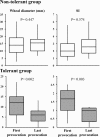Evaluation of the skin-prick test for predicting the outgrowth of cow's milk allergy
- PMID: 28107145
- PMCID: PMC5244269
- DOI: 10.2500/ar.2016.7.0175
Evaluation of the skin-prick test for predicting the outgrowth of cow's milk allergy
Abstract
Background: Although considerable efforts have been made to develop diagnostic tools for predicting the outcome of oral food challenges, tests for predicting the outgrowth of food allergies are lacking.
Objective: The aim of this study was to assess the diagnostic value of the wheal size and skin index (SI) (the ratio of an allergen-induced wheal to a histamine-induced wheal diameter) of the skin-prick test based on the outcome of a controlled oral provocation test for cow's milk. Moreover, we assessed whether wheal size and/or SI were useful for predicting the outgrowth of cow's milk allergy (CMA).
Methods: This study included 135 children with suspected CMA. Eighty-one patients were definitely diagnosed by oral provocation tests for cow's milk, and their wheal diameters, SIs, and cow milk's-specific serum immunoglobulin E concentrations were determined.
Results: The wheal diameters were significantly larger and the SIs significantly higher in children with positive oral provocation test results than in those with negative test results. We found that 50% of the patients were expected to be able to drink cow's milk by age 5 years. In these patients, the wheal diameters were significantly smaller and the SIs significantly lower at the time of CMA outgrowth than at the time of diagnosis, whereas these values were apt to increase in patients who did not outgrow CMA, with no significant difference.
Conclusions: The skin-prick test can be used to diagnose CMA and predict CMA outgrowth. A wheal diameter of 8 mm or/and an SI of 1.0 is informative, not only in diagnosing CMA but also in predicting a natural CMA outgrowth.
Conflict of interest statement
The authors have no conflicts of interest to declare pertaining to this article
Figures


Similar articles
-
Predicting outgrowth of IgE-mediated cow's milk allergy: Diagnostic tests in children under two years of age.Allergol Immunopathol (Madr). 2019 Sep-Oct;47(5):449-456. doi: 10.1016/j.aller.2018.12.007. Epub 2019 Feb 10. Allergol Immunopathol (Madr). 2019. PMID: 30745248
-
Prick-by-Prick Test with Pasteurised Cow's Milk: A Valuable Tool in Paediatric Practice.Biomed Res Int. 2022 Sep 7;2022:9738654. doi: 10.1155/2022/9738654. eCollection 2022. Biomed Res Int. 2022. PMID: 36119935 Free PMC article.
-
Cow's milk allergy (CMA) in children: identification of allergologic tests predictive of food allergy.Eur Ann Allergy Clin Immunol. 2014 May;46(3):100-5. Eur Ann Allergy Clin Immunol. 2014. PMID: 24853567
-
Accuracy of skin prick tests in IgE-mediated adverse reactions to bovine proteins.Ann Allergy Asthma Immunol. 2002 Dec;89(6 Suppl 1):26-32. doi: 10.1016/s1081-1206(10)62119-9. Ann Allergy Asthma Immunol. 2002. PMID: 12487201 Review.
-
Epidemiology of Cow's Milk Allergy.Nutrients. 2019 May 10;11(5):1051. doi: 10.3390/nu11051051. Nutrients. 2019. PMID: 31083388 Free PMC article. Review.
Cited by
-
Analysis of a Large Standardized Food Challenge Data Set to Determine Predictors of Positive Outcome Across Multiple Allergens.Front Immunol. 2018 Nov 27;9:2689. doi: 10.3389/fimmu.2018.02689. eCollection 2018. Front Immunol. 2018. PMID: 30538699 Free PMC article.
-
Oral Immunotherapy for Children with Cow's Milk Allergy.Pathogens. 2021 Oct 15;10(10):1328. doi: 10.3390/pathogens10101328. Pathogens. 2021. PMID: 34684278 Free PMC article. Review.
-
Cow's Milk Protein Allergy as a Model of Food Allergies.Nutrients. 2021 Apr 30;13(5):1525. doi: 10.3390/nu13051525. Nutrients. 2021. PMID: 33946553 Free PMC article. Review.
-
Oral Immunotherapy in Food Allergy: A Critical Pediatric Perspective.Front Pediatr. 2022 Feb 22;10:842196. doi: 10.3389/fped.2022.842196. eCollection 2022. Front Pediatr. 2022. PMID: 35273931 Free PMC article. Review.
-
Specific IgE and skin prick tests to diagnose allergy to fresh and baked cow's milk according to age: a systematic review.Ital J Pediatr. 2017 Oct 12;43(1):93. doi: 10.1186/s13052-017-0410-8. Ital J Pediatr. 2017. PMID: 29025431 Free PMC article.
References
-
- Ben-Shoshan M, Soller L, Harrington DW, et al. Eczema in early childhood, sociodemographic factors and lifestyle habits are associated with food allergy: A nested case-control study. Int Arch Allergy Immunol 166:199–207, 2015. - PubMed
-
- Tanaka LG, El-Dahr JM, Lehrer SB. Double-blind, placebo-controlled corn challenge resulting in anaphylaxis. J Allergy Clin Immunol 107:744, 2001. - PubMed
-
- Sampson HA. Utility of food-specific IgE concentrations in predicting symptomatic food allergy. J Allergy Clin Immunol 107:891–896, 2001. - PubMed
-
- Celik-Bilgili S, Mehl A, Verstege A, et al. The predictive value of specific immunoglobulin E levels in serum for the outcome of oral food challenges. Clin Exp Allergy 35:268–273, 2005. - PubMed
-
- Ackerbauer D, Bublin M, Radauer C, et al. Component-resolved IgE profiles in Austrian patients with a convincing history of peanut allergy. Int Arch Allergy Immunol 166:13–24, 2015. - PubMed
LinkOut - more resources
Full Text Sources
Other Literature Sources

